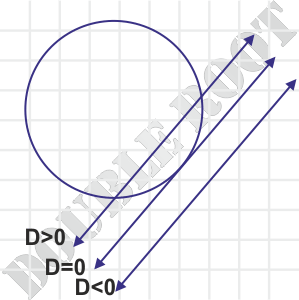This lesson will talk about the intersection of a line and a circle.
Due to its length, I’ll divide the lesson into three parts. The first one will discuss about the position of a line with respect to a circle. The second one will derive a small expression to obtain the length of a chord intercepted by a circle on a line. The last part will discuss the conditions for a line to become a tangent to a circle.
Let’s begin.
Intersection of a Line and a Circle
Given a line and a circle, the line can either
- intersect the circle at two different points,
- touch the circle at only one point, or
- not intersect the circle at all.
Drag the slider in the simulation to explore this.
What will determine whether this line will intersect the circle at two distinct points, touch the circle at one point or will not intersect the circle in any point?
There are two ways to think about this.
Method 1
Let the equation of the circle be x2 + y2 = a2, and that of the line be y = mx + c.
First, if we try to ‘solve’ the two equations in two unknowns, I get a quadratic equation in x, which looks like this
(1 + m2)x2 + 2cmx + c2 – a2 = 0
What do the roots of this quadratic (say x1 and x2) signify geometrically?
Now if you recall, when we were talking about equations in general, the x and the y in equations represent respectively the x and the y coordinates of all points on the curve. Therefore, the roots of the previous equation will represent the x coordinates of the points of intersections of the line and the circle.
In fact, by solving any two equations in coordinate geometry, we obtain the x (or y) coordinates of the points of intersections of the two curves represented by the equations.
As of now, I’m not interested in the roots themselves, but their nature. Now here’s the link – If we obtain two distinct real roots, then the line will intersect the circle at two distinct points. If we obtain two coincident roots, then the line is touching the circle at only one point (i.e. two coincident points). Finally, if we do not obtain any real roots from the formed equation, the line will not touch or intersect the circle.
And how will you determine that? The nature of roots of a quadratic equation is linked to its discriminant. So all we need to do is find the discriminant of the quadratic equation, and check its sign. Positive means intersection at two distinct points, zero implies tangency, and a negative sign would mean the line doesn’t intersect or touch the circle.
Here’s a figure to summarize what I just said.

The exact same method would be valid for determining the position of a line in case of other conic sections i.e. Parabola, Ellipse and Hyperbola as well.
But in the case of circles, geometrical properties will make things a bit easier. Here’s how.
Method 2
To determine the position of a line with respect to a circle, all we need to do is find its distance from the center of the circle, and compare it with its radius. Then,
- if the distance is less than the radius, the line must intersect the circle at two distinct points.
- if the distance is equal to the radius, then the line will touch the circle.
- if the distance is greater than the radius, the line will lie completely outside the circle.
Here’s another simulation, where you can observe the above conditions.
Hope this was simpler to understand, compared to the complicated quadratic equation.
Lesson Summary
To determine the position of a line with respect to a circle, we’ll find its distance from the center of the circle. Let d be this distance and r be the radius of the circle. Then,
- if d < r , then the line cuts the circle at two distinct points.
- if d = r, then the line touches the circle at one point.
- if d > r, then the line does not intersect/touch the circle.
I’ll continue with a few related examples in the next lesson, before moving on to the second part.